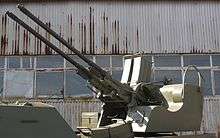M53/59 Praga
The M53/59 Praga is a Czechoslovak self-propelled anti-aircraft gun developed in the late 1950s. It consists of a heavily modified Praga Praga V3S six-wheel drive truck chassis, armed with a twin 30 mm AA autocannon mounted on the rear for which the vehicle typically carries 900 rounds of ammunition, each gun being gravity fed from distinctive 50 round magazines. The vehicle has an armoured cabin.
| M53/59 Praga | |
|---|---|
 M53/59 Praga, self-propelled anti-aircraft gun of Serbian Army | |
| Type | Self-propelled anti-aircraft gun |
| Place of origin | Czechoslovakia |
| Production history | |
| No. built | More than 330[1] |
| Specifications | |
| Mass | 10.3 tonnes |
| Length | 6.92 m (22 ft 8 in) |
| Barrel length | 2.4 m (94 in) |
| Width | 2.35 m (7 ft 9 in) |
| Height | 2.95 m (9 ft 8 in) |
| Crew | 4 (driver, commander and two gun operators) |
| Shell | Fixed QF 30x210mmCz |
| Caliber | 30 mm (1.2 in) |
| Barrels | 2 |
| Elevation | -10° - +85° |
| Traverse | 360° |
| Rate of fire | 500 rpm per barrel cyclic 100 rpm per barrel practical |
| Muzzle velocity | 1,000 m/s (3,300 ft/s) |
| Effective firing range | 3 km (2 mi) effective range[2] |
| Armor | Aluminum |
Main armament | 30 mm twin AA autocannon (900 rounds) |
| Engine | Tatra T 912-2 6-cylinder inline air-cooled diesel 110 hp (82 kW) at 2,200 rpm |
| Power/weight | 10.7 hp/tonne (8 kW/tonne) |
| Suspension | torsion bar |
Operational range | 500 km (310 mi) |
| Maximum speed | 60 km/h (37 mph) |

In Czechoslovakia it was known as Praga PLDvK vz. 53/59 - "Ještěrka" (PLDvK Model 53/59 - "Lizard").[3] PLDvK stands for Protiletadlový dvojkanón = Anti-aircraft twin-gun.
The system is optically aimed and can only be used effectively during the day with good weather conditions. The gun can be dismounted and used independently of the vehicle.
While mostly obsolete in anti-aircraft role, it can be used effectively as a ground support weapon against unarmored or lightly armored targets, as was shown during the Yugoslav wars. It remains in service with armies of Egypt, Libya, Serbia, Slovakia etc.
When Czechoslovakia imported one Soviet-made ZSU-57-2 for testing it considered it to be comparable to M53/59 which was the reason Czechoslovakia refused the Soviet SPAAG.[4]
Operators







Former Operators





.svg.png)
See also
- BRAMS design successor
- Praga (vehicle works)
References
- "M53/59 at ELDON s.r.o". 2003. Archived from the original on 30 September 2007.
- SIPRI Arms Transfers Database
- Foss, Christopher (1977). Jane's pocket book of towed artillery. New York: Collier. p. 225. ISBN 0020806000. OCLC 911907988.
- Translation of "Ještěrka"
- "Militaria Jowitka". Archived from the original on 5 December 2008. Retrieved 28 July 2008.
- International Institute for Strategic Studies (February 2016). The Military Balance 2016. 116. Routledge. p. 81. ISBN 9781857438352.
- Ještěrka šířila hrůzu a uprchlíci s ní proráželi železnou oponu (article in Czech)
- Air Defence weapons of Croatian Army
- Air Defence weapons of Slovenian Army
- http://oklop2.tripod.com/praga/m53.htm
- Air Defence weapons of Yugoslav People's Army